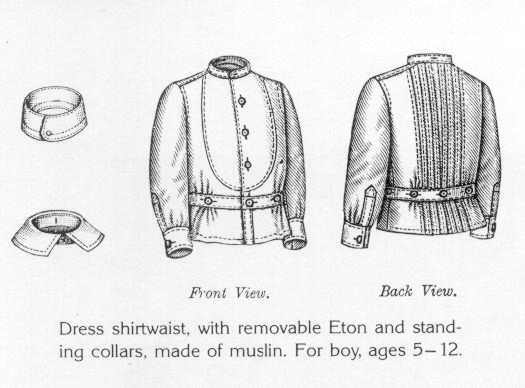
Eton Collars: Detachable

Figure 1.--This illustration from a 1899 issue of the "Delineator" shows a boys' shirtwaist and the detachable collars worn with it. Also notice the buttons on the waist for trousers and stocking supporters and the fact that shirtwaists did not have tails.
|
The Eton collar was a detachable collar. Modern readers are accustomed to buying shirts with the collars attached as an integral part of the shirt. This is not, of course, how shirts used to be bought. During the second half of the 19th cntury and the early 20th cenbtury, one would buy a waist or shirt waist and then several collars to go with it. As vests or waistcoats were common, one would not always change the shirtwist, but often only the collar. This was done for a variety of reasons. It reduced washing, a critical factor in the 19th and early 20th century household and made shirtwaist last longer because the collar is where shirts often wear out first. This ment by simply changing your collar a boy or man could give a very neat, well kept appearnce.
Today we give little attention to washing clothes. It is also so simple with modern blended easy to care for fabrics, washing machines, and an array of detrgents, bleaches, fabric softners and much more. Often teenagers, including boys are now involved with washing clothes. This was not always the case. The family laundry used to be an arduous, back breaking effort perforned only by mothers and daughters. It is thus understandable that children once wore their clothes longer than is the case today and why so much care was taken to protect clothes.
The modern reader may not realize that in the 19th and early 20th century, many shirts came with detachable collars. This was an inovation adopted in the early 19th century, surprisingly in America. Most fashion inovation in the 19th century came from Europe. The detachable collar was invented in 1827 by an American housewife. By mid-century the detachable collar had become quite widespread for dress shirts. This was especially the case with Eton collars, an English fashion which became a staple for boys' wear. Detachable collars were an important labor saving device. Housewives had to wash an entire shirt when it was primarily the collar that wore out. Often the collar of a shirt wore out while the rest of the shirt was still serviceable.
Christopher Wagner

Navigate the Historic Boys' Clothing Web Site:
[Return to the Main Eton collar page]
[Introduction]
[Activities]
[Biographies]
[Chronology]
[Clothing styles]
[Countries]
[Photography]
[Bibliographies]
[Contributions]
[Essays]
[FAQs]
[Glossaries]
[Satellites]
[Tools]
[Boys' Clothing Home]
Navigate the Historic Boys' Clothing Web chronological pages:
[The 1840s]
[The 1850s]
[The 1860s]
[The 1870s]
[The 1880s]
[The 1890s]
[The 1900s]
[The 1910s]
[The 1920s]
[The 1930s]
[The 1940s]
Navigate the Historic Boys' Clothing Web style pages:
[Long pants]
[Knickers]
[Short pants]
[Scottish kilts]
[School uniform]
[Sailor suits]
[Eton suits]
[Ring bearer/page costumes]
Created: March 20, 1998
Last updated: March 2, 2002



